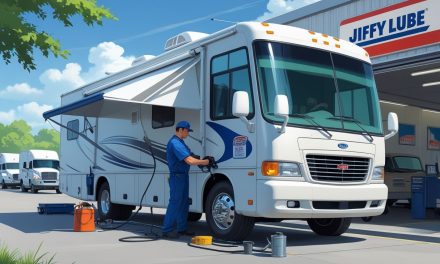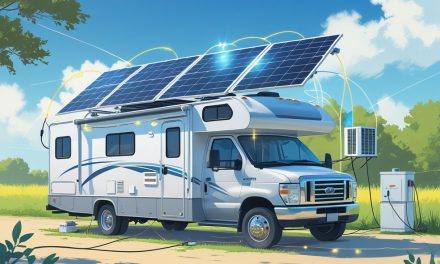Would you like to save this article?
You’ve bought your dream RV, and the dealer sold you on freedom, adventure, and endless open roads. What they conveniently forgot to mention? Your shiny new home-on-wheels needs more attention than a needy teenager. The average camper nowadays only lasts about 10 years, but here’s the kicker—with proper maintenance, you could easily stretch that to 20-30 years. That’s right, you can literally double your RV’s lifespan without needing a degree in mechanical engineering.
The truth is, most RV owners keep their rigs for only 5-7 years before trading up. Not because the RV died, but because they neglected it until it wanted to die. These rolling houses aren’t fragile—they’re just needy. Think of your camper like a relationship: ignore it, and it’ll leak, break down, and embarrass you in public.
1. Clean Your RV Like You Actually Care About It
Let’s start with the basics: cleaning. You’d think this would be obvious, but some folks treat their camper like a self-cleaning oven. They park it under a tree for a year, then wonder why it’s turned into a science experiment covered in algae and bird droppings.
Here’s what you need to do: Use RV-specific soap, not dish soap. Dish soap strips away the protective wax coating faster than your uncle devours Thanksgiving turkey. Grab a soft-bristle brush with a long handle and gently scrub away the bug cemetery that’s accumulated on your windshield. Inside, vacuum up those mysterious crumbs, wipe down counters, and for the love of all things holy, open the windows and let it air out.
According to RV maintenance experts, proper cleaning can significantly extend your RV’s lifespan by preventing mold, mildew, and structural deterioration.
Here’s the Reality Check You Need:
You’re not exfoliating a face—you’re removing evidence of every bug that committed suicide on your front bumper. If you treat your RV like it’s disposable, congratulations, it will be. And when you show up to the campground with green streaks running down the sides, don’t be surprised when other campers avoid making eye contact.
2. Store Your RV Properly (Or Watch It Die a Slow Death)
Leaving your camper outside to fend for itself all year is basically putting it in hospice care. Sun, rain, snow, and UV rays are conspiring to destroy your investment faster than you can say “buyer’s remorse.”
Your best option (though expensive) is indoor RV storage. Second best? An RV carport with overhead protection. Third best? A high-quality, breathable RV cover—not a cheap tarp from Amazon that’ll shred in three months. And please, before you store it, empty the fridge, drain the water system, and crack open cabinets so it doesn’t smell like a crime scene when you return in spring.
| Storage Option | Protection Level | Cost | Lifespan Impact |
|---|---|---|---|
| Indoor Storage | Excellent | $$$$ | Adds 10+ years |
| RV Carport | Very Good | $$$ | Adds 5-8 years |
| Quality RV Cover | Good | $$ | Adds 3-5 years |
| Tarp (LOL) | Poor | $ | Rodent motel |
Why You’ll Regret Ignoring This:
A tarp isn’t a storage plan—it’s basically gift-wrapping your camper for rodents. Leave a carton of milk in your fridge for three months and see what happens. That’s what you’re doing to your RV. Don’t act shocked when you open it next spring and need a hazmat suit.
3. Check Your Tires Before They Leave You Stranded at 3 AM
Let’s talk about tires—the number one reason RVs end up on the side of the road. And it’s not because they wore out while driving. It’s because you haven’t looked at them in three years, and now they resemble beef jerky.
Here’s what you should actually do:
- Check tire pressure before every trip (get an $8 gauge)
- Inspect sidewalls for cracks—if they look like grandma’s elbows, replace them
- Move your camper a foot or two every month to prevent flat spots
- Use tire covers to protect against UV damage
According to the National Highway Traffic Safety Administration, tire blowouts cause more than 78,000 crashes per year in the U.S., with 6% of large vehicle crashes attributed to tire failure.
The Brutal Truth:
Your tires are slowly plotting your downfall. Nothing ruins a vacation faster than being stranded at 3 AM on a dark highway, realizing you forgot to renew your AAA subscription. And when you call your spouse to explain why you’re stuck, good luck sleeping on the couch for the next month.
4. Inspect and Reseal Your Roof (Before It Becomes a $12,000 Problem)
Your RV roof is where dreams go to die. At minimum, get up there twice a year and inspect every seam, antenna, roof vent, and skylight. Walk carefully unless you want to test your insurance deductible.
If you spot cracks, remove the old sealant and apply fresh Dicor self-leveling lap sealant—it’s basically Botox for your rig. For rubber roofs, wash with the right soap and apply UV protectant at least once yearly.
Here’s the scary part: Minor roof leak repairs cost between $150-$400, but if you ignore it, you’re looking at $1,500-$12,000 for major water damage repairs, according to RV repair cost data.
What Happens When You Procrastinate:
Nobody checks their roof until the interior ceiling starts sagging. Then you’re at the dealership hearing “$12,000 for repairs,” and you’re like “But I just bought this thing!” Spoiler alert: You just killed it. Your wallet will hate you, your spouse will hate you, and your RV will hate you most of all.
5. Keep Your Battery Alive (So You Don’t Eat Cold Pop-Tarts in a Parking Lot)
Your RV battery is like that one child you forget about until they need attention. If parked long-term, disconnect the battery so it doesn’t drain. Hook it up to a trickle charger or use a solar panel. Check terminals for corrosion—water, baking soda, and a used toothbrush will clean it up cheap.
Remember: Batteries don’t last forever. Replace it when it won’t hold a charge. Stop trying to revive it like Frankenstein’s monster.
The Parking Lot Pop-Tart Scenario:
You won’t discover your battery is dead until you’re leaving for vacation. Then you’re explaining to your family why they’re eating cold Pop-Tarts in a Walmart parking lot while you run inside for a 27B deep cycle battery. Fun times.
6. Protect Your Plumbing (Because Nobody Wants a Black Tank Catastrophe)
Your RV’s plumbing system is like your digestive system—you won’t think about it until something goes horribly wrong.
Essential plumbing maintenance:
- Drain black and gray tanks after trips (don’t let it marinate)
- Inspect for leaks under sinks, around toilets, and near the water pump
- Winterize before freezing temps—drain lines, add RV antifreeze
- Sanitize your fresh tank with bleach if it smells funky
What Failure to Winterize Looks Like:
Frozen pipes explode like tiny water grenades inside your RV. And if you leave anything in that black tank over winter? You’ll wish you’d just burned the camper down. Spring arrival will be a horror show you can’t unsee.
7. Maintain Your Engine and Generator (Because Breaking Down on Mountains Sucks)
For motorhomes, check belts, hoses, fluids, and stick to an oil change schedule. Don’t wing it. Run your generator at least once monthly under full load to prevent gumming. Use fuel stabilizer if storing for months.
A neglected generator is just an expensive box bolted to your camper. And an ignored engine? It’ll fail on a 97-degree day while climbing a mountain pass with no cell service. Murphy’s Law, RV edition.
The Mountain Pass Nightmare:
Picture this: It’s 97 degrees, you’re climbing a steep mountain pass, your engine starts making noises like a dying whale, and your phone has zero bars. That’s what happens when you skip maintenance. Enjoy explaining that one to your passengers.
8. Maintain Your Interior (Before Mold Throws a Party)
Interior maintenance basics:
- Vacuum regularly
- Wipe down surfaces
- Use furniture covers if needed
- Keep humidity under control
Fun fact: Mold spreads faster in a camper than rumors at a family reunion. One winter of neglect and you’re camping in a rolling science experiment. Nobody wants to sleep in a petri dish on wheels.
9. Keep a Maintenance Log (Because “I Think I Did That” Isn’t a Plan)
Keep a maintenance notebook or spreadsheet. Record:
- Dates of oil changes
- When tires were last checked/replaced
- Roof inspection dates
- Types of products used (sealant, oil, tire size)
Store it in a drawer inside the camper. Without a log, maintenance is just vibes. (“I think I changed the oil last year?” Spoiler: You didn’t.)
Bonus: When you sell, buyers love seeing maintenance logs. It proves you’re not the person who duct-taped water leaks.
10. Drive Like You Have Common Sense (Your RV Isn’t a Sports Car)
Your camper is not a performance vehicle. It’s a rolling box of drywall, plywood, and hope.
Smart driving habits:
- Accelerate slowly (saves transmission and gas)
- Brake gently (your house-on-wheels doesn’t stop like a Civic)
- Take wide turns (real wide—don’t demolish gas pumps)
- Don’t exceed 65 mph—saves gas, sanity, and prevents white-knuckling
If you drive your camper like you stole it, it’ll die like you stole it. The faster you drive, the faster it breaks. Screws come loose, cupboards pop open, and you’re basically vibrating your house apart.
Final Thoughts
There you have it: 10 simple ways to double your RV’s lifespan. Clean it, store it, maintain it, and drive it with some sense. Do these things and your camper will last for decades. Ignore them, and you’ll be back at the dealership shopping for a new one before your credit score recovers from the first purchase.
At the end of the day, RVs aren’t fragile—they’re just needy. Take care of yours, and it’ll reward you with years of adventures. Neglect it, and you’ll be telling sad stories at campgrounds about “that time the floor collapsed.”
Your move, RV owner.
SOURCES
- The Camping Loop – Top 10 Ways To Easily Double The Life Of Your Camper
- RVshare – How Long Do RVs Last: Lifespan of RV Classes
- Rec Nation Storage – How Long Does the Average RV Owner Keep Their RV
- Cruise America – RV Lifespan: Averages & What to Expect
- Neighbor – How Long Do RVs Last? Life Expectancy Guide
- Elite RV Pros – The Cost of Neglecting RV Roof Leaks
- Coohom – Understanding RV Roof Leak Repair Costs
- Tool Troopers – RV Tire Blowouts: Causes and Prevention
- Batta Fulkerson – Tire Blowout Statistics & Damage Information
- Good Sam ESP – Top 10 Most Expensive Items to Fix on Your RV





